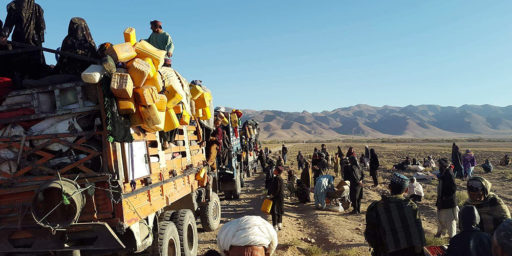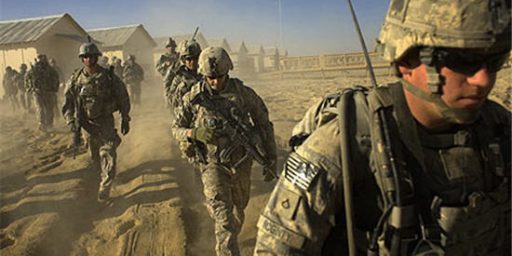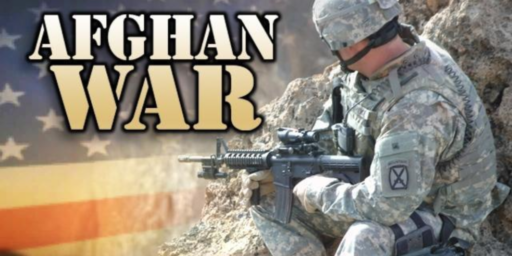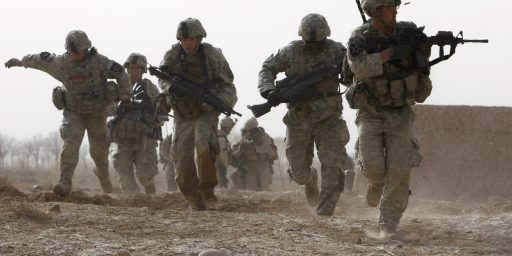U.S. Forces In Afghanistan Involved In More Than Just Counterterrorism Despite Obama’s Promises
U.S forces in Afghanistan have been involved in missions that go far beyond the counterterror mission the Obama Administration said they would be limited to.
The New York Times reports that American forces in Afghanistan have been engaging in activities that go well beyond the counterterrorism mission that the Obama Administration has said they would be limited to going forward:
KABUL, Afghanistan — Months after President Obama formally declared that the United States’ long war against the Taliban was over in Afghanistan, the American military is regularly conducting airstrikes against low-level insurgent forces and sending Special Operations troops directly into harm’s way under the guise of “training and advising.”
In justifying the continued presence of the American forces in Afghanistan, administration officials have insisted that the troops’ role is relegated to counterterrorism, defined as tracking down the remnants of Al Qaeda and other global terrorist groups, and training and advising the Afghan security forces who have assumed the bulk of the fight.
In public, officials have emphasized that the Taliban are not being targeted unless it is for “force protection” — where the insurgents were immediately threatening American forces.
But interviews with American and Western officials in Kabul and Washington offer a picture of a more aggressive range of military operations against the Taliban in recent months, as the insurgents have continued to make gains against struggling government forces.
Rather than ending the American war in Afghanistan, the military is using its wide latitude to instead transform it into a continuing campaign of airstrikes — mostly drone missions — and Special Operations raids that have in practice stretched or broken the parameters publicly described by the White House.
Western and military officials said that American and NATO forces conducted 52 airstrikes in March, months after the official end of the combat mission. Many of these air assaults, which totaled 128 in the first three months of this year, targeted low- to midlevel Taliban commanders in the most remote reaches of Afghanistan.
As early as January, when officials in Washington were hailing the end of the combat mission, about 40 American Special Operations troops were deployed to Kunar Province to advise Afghan forces that were engaged with the Taliban over a handful of villages along the border with Pakistan.
With the troops on the ground, the command for the American-led coalition called in airstrikes under the authority of force protection, according to two Western military officials, who spoke on the condition of anonymity because the details of the operation are not public.
“They are putting guys on the ground in places to justify the airstrikes,” one of the officials said. “It’s not force protection when they are going on the offensive.”
Commenting on the continuing military operations against the Taliban, the top American commander in Afghanistan, Gen. John F. Campbell, vehemently denied accusations that he was putting troops into harm’s way just to enable more airstrikes.
He has insisted that it is within his purview to target Taliban insurgents who pose a threat to not just American or NATO troops but to any Afghan security forces. And his options on the ground were clear, he said in an interview, even if Washington’s public description of them was not.
“Washington is going to have to say what they say politically for many different audiences, and I have no issue with that,” General Campbell said. “I understand my authorities and what I have to do with Afghanistan’s forces and my forces. And if that doesn’t sell good for a media piece then, again, I can’t worry about it.”
He added: “Combat and war and transition, as you know, it’s a very complex thing. For me, it’s not black and white.”
The operations are continuing during a troubling stretch for the Afghan security forces, as the Taliban are continuing to make gains. Members of the nation’s military and police forces were killed by the insurgents at a high rate last year. And in the first three months of this year, things already appeared worse: The casualty rate rose 54 percent over the same period last year, according to one Western and one Afghan official, who spoke on the condition of anonymity because the figures are not public.
The danger was highlighted in recent days in the northern province of Kunduz, where the Afghan Army has been forced to send thousands of reinforcements to beat back a major Taliban offensive. In addition to threatening to claim at least one district, the insurgents have come within a few miles of the provincial capital, officials in Kunduz said. Coalition forces deployed jets to the area in a show of force but no munitions were dropped, officials said.
In that environment, American military officials have been reluctant to let go of the war, arguing that their involvement remains necessary given the Taliban threat and changing regional factors.
It was just last month, of course, that President Obama announced that he was slowing the pace of the planned withdrawal of American forces from Afghanistan, which is supposed to be complete by the end of 2016, would be slowed down due to concerns about the security condition in the country that have been expressed by Afghan President Ashraf Ghani. At that time, however, the Administration stressed that the forces that were being left behind would be limited to counterterrorism operations and would not be engaging directly with the Taliban in engagements related to the ongoing civil war in the country. Responsibility for that aspect of Afghanistan’s security was supposed to have been handed over to the security forces that Americans have been spending the last several years training specifically for this task. Instead, it would appear that American forces are continuing to engage in many of the same missions that they did in the past notwithstanding the assurances that the Administration has made that this wasn’t going to be the case. Whether this is something that is a conscious decision on the part of the powers that be in Washington or the result of actions by commanders on the ground is unclear, but it seems fairly serious either way. If it’s the first option, then the Administration is essentially misrepresenting the nature of our ongoing mission in Afghanistan to the public. If it’s the later, then the commanders are arguably acting beyond the scope of the authority.
The other problem that this news raises, of course, is the fact that the tactics we’re engaging in now haven’t exactly been helpful in the past:
Beyond any discrepancy over mission descriptions, American airstrikes in Afghanistan have a fraught history. A high number of civilian casualties in such strikes created increasing tensions with Afghan officials and the public, and in recent years those missions had been sharply restrained to cut the risk.
Even though American officials argue that drone strikes are controlled and precise, in truth they have been far from trouble free — a fact highlighted last week when an American drone strike accidentally killed American and Italian hostages of Al Qaeda in Pakistan.
Those civilian casualties, of course, have created significant resentment among Afghans and Pakistanis over the years, and arguably have done more to help al Qaeda and other radical groups recruit new followers than they have actually helped in the War On Terror. Why we’re back to using a tactic like this is something I’ll leave others to figure out, but it certainly doesn’t make any sense. More importantly, it certainly doesn’t sound like we’re disengaging from Afghanistan at all regardless of what the Obama Administration is saying.






I guess I’m not seeing the problem here. The new government of Mr. Ghani lacks the manic dysfunction of the Bush-installed Mr. Karzai and if we can actually manage to prop him up in Kabul, I’m not quite seeing why the better tack would be to let the Taliban sweep in.
Listen to the weaseling and hidden manipulation in this paragraph from the NYT:
Forced to send in reinforcements? How is that judged, exactly? Reinforcements are there to reinforce. The fact that the reinforcements exist and are in place rather suggests that their use is contemplated.
“Beat back a major Taliban offensive.” So, the Taliban attacked and was defeated?
“In addition to threatening to claim at least one district,” is a meaningless phrase, one meant to worry the reader, but what does it mean? The Taliban has thus far failed to claim that district? They’ve been trying, but they have so-far at least, failed. Right? And that failure is presumably down to the Afghan army with some US help. Is that supposed to be a bad thing?
“the insurgents have come within a few miles of the provincial capital.” In other words, what? A Taliban army was three miles away? Ten miles away? Or was it just a smaller unit, a platoon of Taliban, maybe 9 miles away. Three old Taliban caught a bus to the outskirts? What does it mean in any real military sort of way?
“Coalition forces deployed jets to the area in a show of force but no munitions were dropped,” In other words, no targets were spotted. Which suggests that approach to Kunduz was nearer to being my three imagined Talibs taking the Greyhound into the suburbs.
That entire paragraph is intended to create an impression that an objective reading of the reportage does not support. IN fact, the whole piece is that way. It borders on propaganda.
We need to remember something: we still don’t want the Taliban to win. They are still scum of the earth. And if we can keep them out of major cities with the kind of minimal effort outlined in the piece, good.
I had a rather lengthy response in the works, but as usual Michael said what I was intending to say and did so better than I could have.
This NYT article is hand-wringing and borderline propaganda. I’ll give it the consideration that it’s due.
@HarvardLaw92:
I had to write fast. I felt you closing in.
@michael reynolds:
Nah, I had barely started / was organizing my thoughts when you posted. I have a lot of other things on my mind at present. Eloquent statement, as usual, so I simply disengaged and expressed agreement instead.
Doug,
Are you suggesting that the same person that told us that if we like our insurance and our doctors we could keep them, period…is a liar?
Color me unsurprised.
Here’s a phrase you could’ve found in 2004.